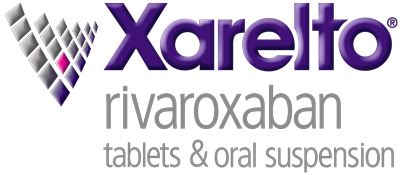What is XARELTO®?
XARELTO® belongs to a group of medicines called direct oral anticoagulants, or DOACs for short. Like other DOACs, XARELTO® has no known dietary restrictions, no requirements for frequent blood tests, and few drug interactions.
XARELTO® helps reduce the risk for blood clots and the life-threatening events they can cause.
XARELTO® slows your body's ability to clot by selectively blocking one of the clotting factors found in your blood — an enzyme called Factor Xa ("10a").
Take one 10-mg tabletonce a day, with or without food
![]()
Tablets shown not actual size
How do you take XARELTO®?
- If you miss a dose of XARELTO®, take it as soon as you remember on the same day. Take your next dose at your regularly scheduled time.
- Take one 10-mg tablet once a day, with or without food.
- Remember, there are no known dietary restrictions, unlike warfarin (Coumadin®).
A few things to remember:
- Do not change your dose or stop taking XARELTO® unless your healthcare professional tells you to. Stopping XARELTO® increases your risk of having a stroke.
- Tell all the healthcare professionals you see, including your dentist, that you’re taking XARELTO®. They should talk to the healthcare professional who prescribed XARELTO® before any surgical, medical, or dental procedure. Your doctor will tell you when to stop taking XARELTO® and when to start taking XARELTO® again after your surgery or procedure.
- Tell your healthcare professional about all the medicines you take, including prescription and over-the-counter medicines, vitamins, and herbal supplements.
What is the risk of a blood clot during and after a hospital stay?
When you are in the hospital, limited movement and other risk factors can mean your blood flow is slower than normal, which increases the chance that a DVT or PE blood clot will form. What's more, hospitalization for some illnesses can increase your risk more than 10 times:
- Pneumonia
- Stroke (particularly ischemic stroke)
- Heart failure
The risk for DVT and PE blood clots doesn’t always go away once your hospital stay is over. In fact, the risk for developing a DVT or PE is especially high during the first weeks after being discharged from the hospital.
How common are DVT and PE blood clots after hospitalization?
Each year, more than 8 million Americans are at risk for experiencing DVT or PE blood clots that are related to a hospital stay.
- About half of all DVT and PE blood clots are related to being hospitalized, and these blood clots typically occur within the first 3 months of hospital stay
- According to a study, 86% of people who developed a DVT or PE within 3 months after discharge ended up back in the hospital†
*According to the Centers for Disease Control and Prevention (CDC).
†Study conducted from 2005 to 2010.
What is a DVT?
A deep vein thrombosis, or DVT, is a blood clot that occurs in a vein, often when blood flow slows down. For example, if you have to spend a lot of time in bed because of a hospitalization, your blood flow could slow down enough to form a clot.
How does a DVT blood clot form?
Watch this short video to see how a DVT forms and the symptoms it can cause.
What are the symptoms of a DVT?
- Swelling of the leg or affected area
- Pain or tenderness at rest or when standing or walking
- Skin that is warm to the touch
- Skin that is red or discolored
What is a PE?
A pulmonary embolism, or PE, is a potentially life-threatening event that happens when a DVT blood clot breaks off and travels through the bloodstream to the lungs.
How does a blood clot become a PE?
Watch a short video to see how a DVT blood clot can cause a PE, and the symptoms to look out for.
What are the symptoms of a PE?
- Unexplained shortness of breath
- Rapid breathing
- Chest pain that may worsen with coughing or deep breathing
- Coughing or coughing up blood
- A rapid or irregular heartbeat
- Feeling lightheaded or passing out
Are there any side effects associated with XARELTO® in adults?
Side effects of XARELTO®:
-
Increased risk of bleeding
- You are likely to bruise more easily and it may take longer for the bleeding to stop
Your risk of bleeding increases if you take XARELTO® with other medicines that also increase your risk of bleeding, such as:
-
- Aspirin or aspirin-containing products
- Long-term (chronic) use of non-steroidal anti-inflammatory drugs (NSAIDs)
- Warfarin sodium (Coumadin®, Jantoven®)
- Any medicine that contains heparin
-
- Clopidogrel (Plavix®)
- Selective serotonin reuptake inhibitors (SSRIs)
- Serotonin norepinephrine reuptake inhibitors (SNRIs)
- Other medicines to prevent or treat blood clots
Always tell your healthcare professional if you experience any side effects while taking XARELTO®—keeping an open and honest conversation going with your healthcare professional will help you get the best care.

How does XARELTO® work?
XARELTO® slows your body's ability to clot by selectively blocking one of the clotting factors found in your blood—an enzyme called Factor Xa ("10a").

